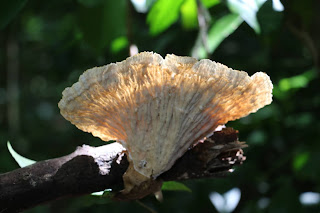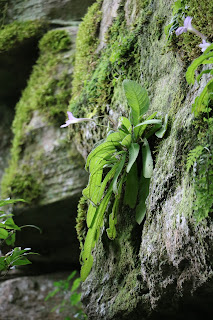We decided to explore Smedmore as when looking
back through records we hadn't gone there for a while and yet it had felt like
yesterday that we had. It's an area where there is both grassland and
forest which makes for great botanising as one can dip into both areas with
ease.
It was hot and so we
were swayed quite easily into first botanising in the coolth of the forest where moss grows on huge
rocks and it's difficult to identify a tree as the trunks lengthen up into
the sky as does the tree in "The Magic Far-away Tree" by Enid Blyton. The only clue is perhaps finding seeds or flowers that have fallen. It's the most beautiful area and one does not have to
go very far at all on foot as there is so much to see, the only challenge is the steepness.
On the forests edge we
saw Tritonia disticha both in white and its usual orange flame
colour. Graham had told me that the white form which I had spotted two weeks up in Oribi Gorge was mainly found in the Eastern Cape. It goes by the same name regardless of colour.
It was lovely to see
the Crocosmia aurea flowering in dappled shade, it's so delicate and whimsical
and it's a flower that always brings me joy when seeing it. I spotted the
tiny Polygala macowaniana growing in a little lush bed of
compost between rocks. Dorothy pointed out how to identify it easily
depending on if it had a "boat" or not.
Disperis
anthoceros grew in the shade and Peperomia retusa clung
onto rock edges. We had to take out our magnifying glasses to see
flowers/seed. It was minuscule.
We had to narrowly miss a Kite spider who dangled in front
of faces as we didn't want to disturb her web that she had so carefully crafted.
Streptocarphus
formosus were on show and
flowering away and we then found Steptocarphus haygarthii a
little higher up when we exited the forest floor. Liparis bowkeri, Hypoxis membranaceus, Stenoglottis macloughnii and Stenoglottis fimbriata were nestled
deeply on the cliff's edge where if one wasn't sure footed one could accidentally
fall stories below and probably never to be found. It was a risk worth
taking as to find and see these wonders that grow where man does not tread is
such a joy.
We had cautiously crawled
out of the forest on all fours and saw Cryptolepis capensis and Faurea macnaughtonii in flower. As soon as we reached the grasslands, we were
devoured by scurrying large ants which raced in every direction like rush-hour traffic leaving us
smearing our legs and boots with Vicks hoping that it would deter them from crawling up into our clothes. We all looked like we where doing the gum-boot dance. They ended up being the game changer
as they were such a menace that we decided to call it a day, we had seen
wonderful things and headed peacefully home.
 |
Cryptolepis capensis
|
 |
Faurea macnaughtonii |
 |
Monsonia natalensis |
 |
Crassula pellucida subsp brachypetala |
 |
Tritonia disticha in white |
 |
Tritonia disticha |
 |
Crocosmia aurea |
 |
Dorothy - The photo was taken from within a cave. |
 |
A Kite spider |
 |
Rachel looking down at the wonders below from great heights. |

|
| A mock absail holding onto roots decending. |
 |
Peperomia retusa |
 |
Thunbergia pupurata |
 |
Streptocarpus haygarthii

| Dorothy photographing Streptocarpus haygarthii.
|
|
 |
Streptocarpus formosus |
 |
Stenoglottis macloughlinii |
 |
Stenoglottis fimbriata |
 |
|
 |
|
 |
Liparis remota
 |
Hypoxis membranaceus
|
|
Pachycarpus grandiflorus subsp. grandiflorus
 |
Inspecting for pollination of the Pachycarpus grandiflorus subsp. grandiflorus |
 |
A huge fruit capsule of a Pachycarpus species. |
 |
Pachycarpus coronarius |
 |
Monanthotaxis caffra
Anne was telling Simon who joined us that the way the Southbroom Conservancy taught the staff when observing this tree was in turning over its leaf and seeing that it was blue like money and that one needed it to catch a taxi. It's small things like this that one remembers the plants name by. |
 |
Polygala macowaniana |
 |
Indigastrum fastigiatum |
 |
| Aloe maculata |
 |
Aloe maculata |
 |
Maggie cautiously entering a cave. |
 |
Maggie at rest after our having our lunch high up the
canopy of trees and looking down into the forest below. |
 |
| Cissampelos torulosa |
 |
Rachel sitting amongst orchids. |

|
| C.R.E.W. exploring the slopes with sheer drops off the edge. There's no room for error. |
 |
Schizoglossum bidens subsp bidens |
 |
Isoglossa cooperi |
 |
Justicia tubulosa (was Siphonoglossa leptantha) |
 |
Colpoon compressum |
 |
Gnidia coriacea |
 |
Aspalathus dalhgrenii |
 |
Helichrysum nudifolium |
 |
Flagellaria guineensis |
 |
Disperis anthoceros |
 |
Heading home on and treading quickly as the earth was riddled
in large ants that could carry us away if we walked too slowly. |

|
Rachel Jarvis, Gail Bowers-Winters, Simon, Maggie Abbott,
Dorothy McIntyre, Anne Skelton and Alf Hayter.
It is with the greatest respect to our elders in their teaching and example. Thank you to all of the above including Kate and Graham Grieve in assisting me in the idenfication process to make this blog possible. |





























































































